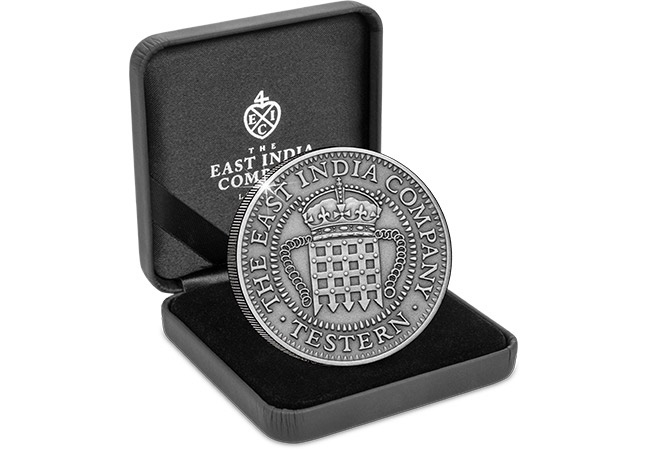Posts Tagged ‘numismatics’
Will these coins bring you luck?
Do you believe in luck? Have you ever owned an item you consider lucky, such as a piece of clothing or perhaps a coin?
Money in general has been considered a source of luck for hundreds of years, such as the lucky penny or the action of throwing money into a fountain to bring fortune. Now let me tell you about a very special ‘lucky’ coin.
The Lucky Angel Coin is one of the most impressive and desirable of all European gold coins, not only due to its beautiful design, but because it is thought to bring such great luck.
The Design:
- The angel depicted on the obverse represents the Spirit of France and is shown writing the French Constitution.
- A rooster appears next to the angel as a symbol of vigilance.
- Behind the angel stands the fasces – previously carried by Roman magistrates as a representation of power.
- On top of this is the Cap of Liberty.
Let’s start at the beginning.
Legend has it that an earlier version of this coin accompanied Napoleon in his rise to power in France and on each heroic campaign, until he arrogantly flung his coin into the river… on the eve of the Battle of Waterloo, in which he was defeated and ended his rule as the French Emperor!
This coin was then re-created during the French Revolution and Augustin Dupré was commissioned by King Louis XVI to design it. He was a firm believer in the power of guardian angels and incorporated this theme into his design.
Years later he fell out of favour with the king and was condemned to death. Dupré claimed that the Angel coin saved him from the guillotine because he had it in his pocket. He said a quick prayer as he knelt beneath the deadly blade and rubbed his coin for good luck. Suddenly a bolt of lightning struck nearby, causing a panic and halting his execution! Before it could be rescheduled, Dupré was granted a pardon, his life saved.
From that moment on it became known as the ‘Angel Coin’ and many stories were told of the wonders of the coin.
Fishermen never went to sea without it, WWI French pilots never flew without it.
Even pilots from Britain and the United States carried the French coins into battle with them. US pilots continued to put their faith in the coin’s protective powers during the Korean and Vietnam Wars.
In fact, the legend of these coins carried such weight that Hermann Goering, the engineer of Hitler’s evil vision, ordered his soldiers to round them up and had them buried in a location that has never been discovered.
The legend continues.
To this day, many pilots, rescue and police heroes proclaim the Angel’s power of luck and protection.
Some blame the coin’s remarkable good fortune on coincidence, others luck, and others a reward for faith. Who knows what these coins actually do, but their legend in itself is enough to want to own one!
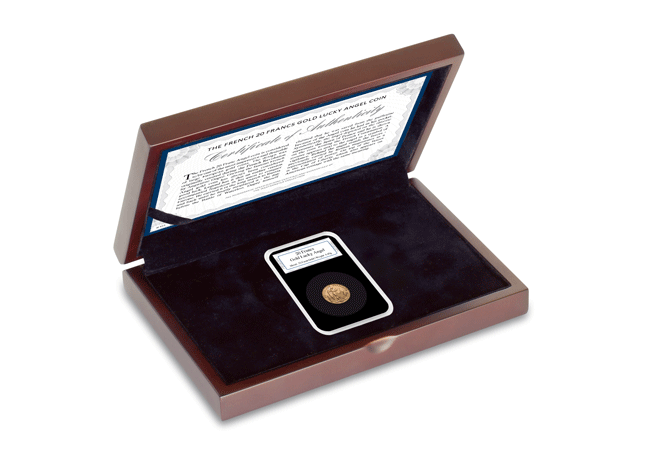
If you’re interested…
You have the unique chance to own the world’s luckiest coin… will you be lucky enough to secure one? Click here to find out more
The story behind England’s first colonial coinage…
The story behind England’s first colonial coinage is one that few people know about. It begins with the most influential company in world history – The East India Company…
The East India Company today are producers and distributors of quality, exclusive and exotic goods with a 400 year legacy through its trade history, which built the British Empire.
Originally, the East India Company was a band of pioneering merchants who were granted a Royal Charter by Elizabeth I in 1600 to explore the East Indies and bring back exotic goods to the Regal West. In doing so they established new trade routes and broke down the barriers of the world. They established Singapore and Hong Kong, held Napoleon captive in St. Helena and sent the tea that was destroyed at the Boston Tea Party.
The consequences of the Company’s actions are the very fabric of our Commonwealth.
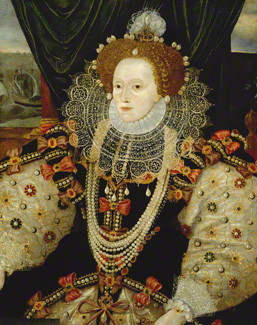
Queen Elizabeth I
England’s very first colonial coinage – struck for the company’s first voyage
In 1601, Queen Elizabeth I signed a Royal Charter awarding The East India Company the right to monopoly on trade in the East.
On signing the Royal Charter, Queen Elizabeth I instructed The Royal Mint to strike England’s very first colonial coinage – the Testern coin. Struck specifically for The Company’s first voyage to the East, the Testern was the very first currency that was minted specifically for trade outside of England.
Following the defeat of Spain in the Spanish Armada in 1588 and after the death of Prince Philip of Spain, the British colonial era of empire commenced and the start of 270 years of trade and conquest began.

The Originial Testern Coin
It’s believed that Queen Elizabeth I insisted on her own trade coinage as means of demonstrating that she was just as powerful as the King of Spain, which would only be effective if it was based on the prevailing international trade coin of the time – the Spanish Real. So, she introduced a coin that was minted in the exact same specification as the Spanish 8 Real denomination, commonly known as ‘Pieces of Eight’. This coin was formally named the Testern but came to be known as ‘Portcullis Money’ due to its unique Portcullis design.
The end of the Testern
Elizabeth I insisted that The East India Company carried the new Testern coins on each voyage, as means of exhibiting her power overseas. Just over £6,000 worth of ‘Portcullis Money’ was loaded onto the vessels of Sir James Lancaster VI’s fleet – the first fleet of The Company. When the fleet arrived in the East many of the coins were melted down, and very few returned to England. In fact, those that did were presented to The Company’s shareholders.
A coin found only in museums

The 2017 Silver Testern Coin
Today, you will only find these coins in museums and even then only a very small number of the Testern ‘Portcullis Money’ coins will be exhibited across the world.
This year, The East India Company and St Helena government have issued the Testern coin in Silver featuring a design based on the original ‘Portcullis money’ and struck in the same weight specification as the Testern coins. Only the second ever minting of Portcullis Money, the design features the iconic portcullis engraving just as its 1601 predecessor.
If you’re interested…
Fully approved by Her Majesty Queen Elizabeth II and strictly limited to just 10,000 coins worldwide, you can own the 2017 Testern Silver coin today if you’re quick.
Released today: the new 2017 United Kingdom Prince Philip £5 coin
On 4th May Buckingham Palace announced that HRH the Duke of Edinburgh, after 70 years at Her Majesty’s side, would be retiring from public duty. To mark this record-breaking achievement, and celebrate his 70 years of service to Her Majesty the Queen, The Royal Mint have today released a brand new design in tribute to Prince Philip.
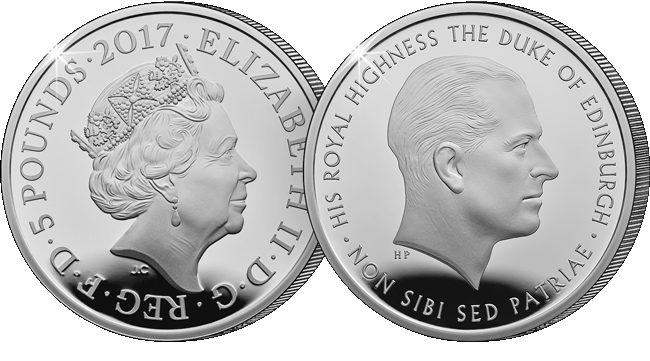
The design features Humphrey Paget’s (1893-1974) portrait of The Duke of Edinburgh. Paget’s legacy was much more than just this portrait though – he is now considered to be one of the most exceptional coin artists of the 20th century.
The Royal Mint’s coin designer Lee R. Jones has added to the portrait to include a table inscription and an edge inscription. The final design has been officially approved by Prince Philip himself.
The coin is available in Gold Proof, Silver and Brilliant Uncirculated Base Metal. Here’s your guide to the new 2017 United Kingdom Prince Philip £5 coin range:
Perfect Quality. Very Affordable.
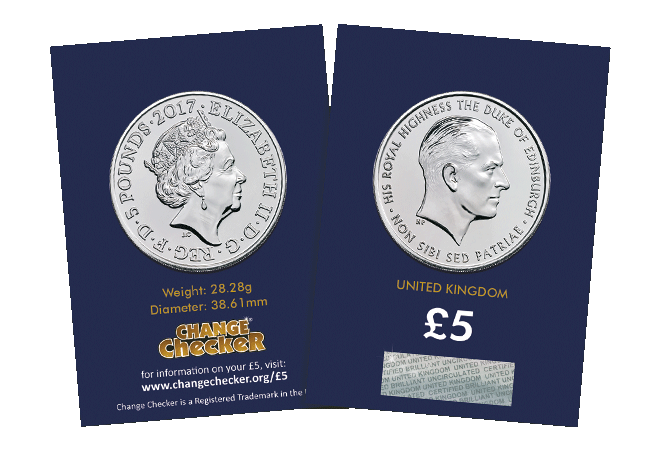
The Prince Philip CERTIFIED BU £5 Coin
The Royal Mint is releasing a brilliant uncirculated base metal version of the Prince Philip £5 coin. These coins have been specially struck and carefully handled to ensure that they are free of scratches and chips found amongst circulating coins.
Known as Brilliant Uncirculated (BU), they are available for £13.00 in a Royal Mint Presentation Pack or £10.99 in a Change Checker Certified Brilliant Uncirculated Collector Card.
Silver Proof – the Collector’s Favourite.
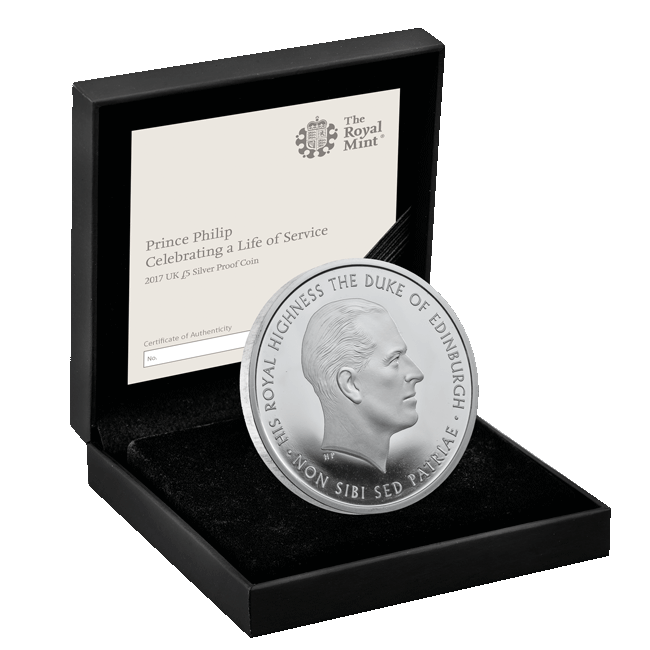
UK 2017 Prince Philip Silver Proof £5
The Silver Proof £5 coin is firmly established as the most sought-after coin amongst collectors because they have all the qualities that collectors really desire.
- Precious metal content – struck from 925/1000 Sterling Silver
- Strictly Limited Edition – just 3,000 coins. That’s EVEN LESS than the last UK Prince Philip coin issued for his 90th birthday. With a mintage of 4,599 it was, at the time, the most limited Silver Proof UK £5 coin ever issued.
- The perfect Proof Finish – even better than Brilliant Uncirulated. Proof coins are struck several times using specially polished dies to create a flawless finish with a perfect mirrored background. The ultimate coin quality.
The Gold Standard
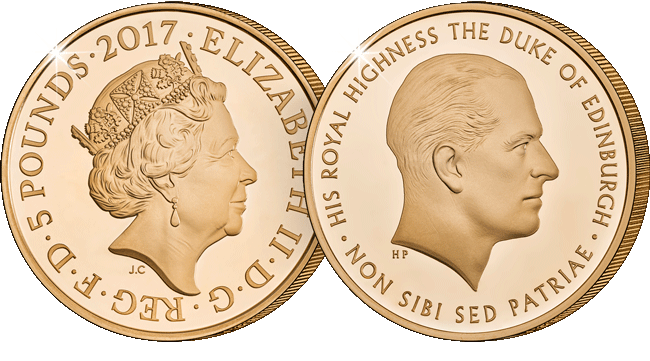
UK 2017 Prince Philip Gold Proof £5
For the ultimate limited edition, a Gold Proof coin has also been issued. Struck in 22 carat Gold, just 300 of these coins have been authorised for release.
If you’re interested …
You can own one of the Prince Philip £5 Coins. Click here to see the range >>



